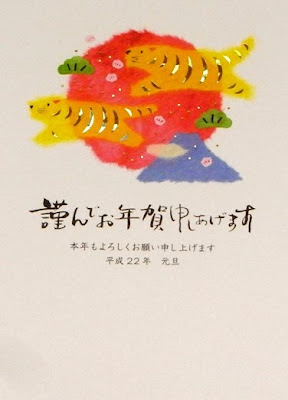New Year’s Day (shogatsu) is considered to be one of the most important annual festivals in Japan and has been celebrated for centuries with many unique customs. Traditionally there is a custom of calling on relatives, neighbors, and people who bestowed kindness upon us during the first few days of the New Year. But after the post office began issuing postcards called nengajo in the Meiji period, people began sending these cards as a form of greeting for the New Year. Japanese people send nengajo cards to friends, acquaintances, former teachers, customers and clients every year. These postcards are used to express gratitude or maintain friendships.
Nengajo postcards are available in many different printed designs. Nengajo often use the zodiac animal (eto) of the present year as the design. The animal of the year 2010 is tiger. The postcards usually have spaces for the sender to write a personal message. Conventional nengajo greetings are ‘kotoshi mo yoroshiku onegaishimasu’ (I hope for your favor again in the coming year), ‘shinnen akemashite omedetogozaimasu’ (Happiness to you on the dawn of a New Year), ‘kinga shinnen’ (Happy New Year), and ‘shoshun’ (literally early spring). Since I am unable to write in Japanese language, hubby has to write nengajo postcards for his as well as my colleagues, teachers, and friends. This usually takes up one full day of a weekend in December. I am really thankful to hubby for writing the addresses on nengajo cards for my friends and past colleagues. This year we used nengajo cards with various designs.

Nengajo postcards are available in many different printed designs. Nengajo often use the zodiac animal (eto) of the present year as the design. The animal of the year 2010 is tiger. The postcards usually have spaces for the sender to write a personal message. Conventional nengajo greetings are ‘kotoshi mo yoroshiku onegaishimasu’ (I hope for your favor again in the coming year), ‘shinnen akemashite omedetogozaimasu’ (Happiness to you on the dawn of a New Year), ‘kinga shinnen’ (Happy New Year), and ‘shoshun’ (literally early spring). Since I am unable to write in Japanese language, hubby has to write nengajo postcards for his as well as my colleagues, teachers, and friends. This usually takes up one full day of a weekend in December. I am really thankful to hubby for writing the addresses on nengajo cards for my friends and past colleagues. This year we used nengajo cards with various designs.

Various designs of nengajo cards we send to friends and colleagues
Various designs of nengajo cards
Nengajo postcards are also available with the reverse sides left blank. People put their own original designs in the blank space of the postcards by using various means of printing. Some use their home computers and printers, others hand-draw or paint their designs, and still others use wood block or other printmaking methods. Cards nowadays commonly include recent news along with family photo.
Japan Post service accepts nengajo cards from mid-December, stock them until December end, and deliver them on New Year's Day. It is best to mail nengajo cards before December 25th, as the postal service then ensures their delivery on January 1st. Nengajo cards should not arrive before New Year's Day.
People usually use prepaid nengajo cards purchased from Japan Post that have a lottery number on each card. On January 15th, the winning numbers are picked and the results are announced on television and in newspapers. Depending on the prize category, the holders of winning numbers receive prizes like television set, car navigation system, washer/dryer, CD player, camera, regional products gift pack, or a collection of commemorative stamps.

Front side of a sample prepaid nengajo card. Circled portion at the bottom right hand corner is the lottery number.
People are happy to receive and read nengajo cards on New Year's Day. Every year hubby and I eagerly look forward to reading the nengajo cards received from friends, colleagues, and teachers.

Hubby reading nengajo cards received from friends and colleagues
Shinnen akemashite omedetogozaimasu
























No comments:
Post a Comment